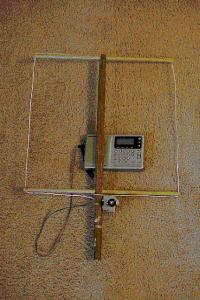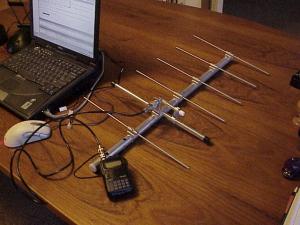How To Quickly Locate And Fix Power Line Interference
by Gene Preston K5GP
 |
Gene Preston K5GP's HF loop
antenna and portable
receiver.
Click here for a schematic.
|
I worked for a power company for 28 years as an engineer and helped my
company track down radio noise complaints. Now I'm retired and help hams
here in Austin, Texas track down their power line noise. The big problem
for both you and the power company (working together) is to find the exact
pole the noise is coming from. Helping the power company find the source of
the noise will greatly speed things up for you. You can start looking for
the noise source with a loop antenna and an HF (or
AM broadcast band) receiver to find a likely pole. If loose hardware is
the problem, the noise will cut in and out with a little motion of the pole
and/or wires. If motion causes the noise to vary, ask the power company to
tighten up all the hardware on the pole. This type of noise has the
characteristic of going away when it rains. If your noise is present when
it rains, proceed as described below.
If your noise is present when it is raining, the faulty component is
probably a bad fuse, bad ligntning arrestor, or leaky insulator, but
probably not a bad transformer, since oil-filled transformers tend to
self-destruct with any internal arcing. These components will not change in
noise intensity when shaking a pole.
To pinpoint the exact pole for bad components requires the use of a hand-held
directional antenna with a VHF or UHF receiver used in AM or SSB mode. An S
meter is not needed. I use a six-element 440 MHz yagi with a Yaesu VX-5R HT
in the AM mode. A 2M quad or three-element 2M yagi will also work fine. FM
mode will not work. You should be able to hear the noise up to about 100
feet from the source on 144 and 440 MHz. Once the pole is located, you are
now ready to call the power company and schedule them to meet you at the
site of that specific pole. Get them to schedule a specific date and time.
Your knowledge of the specific source of noise helps in getting this meeting
scheduled.
 |
Gene Preston K5GP's 440 MHz yagi and
hand-held
receiver (used in AM mode.)
|
You shouild be present at the noise site with your receiver listening to
the noise when the power company is working on the pole, so you can tell
them if their work has fixed the problem.
My suggestion for the power company is to do the following: 1) use a hotstick
to push on different wires to see if any wires are associated with the noise
source, 2) tighten all the hardware, especially the hardware supporting the
main conductors and/or crossarms since they usually have leakage currents
that make noise on the galvanized bolts going through the wooden pole, 3)
disconnect the lightning arrestor(s), 4) jumper around the fuse
disconnect(s) and then disconnect the fuse from the circuit, and finally 5)
change out insulators (this is a more difficult task and is usually not the
problem, unless there is a slack span with bell insulators). If slack span
bell insulators are the problem, ask the power company to spray WD40 inside
the bell insulators and then tighten up the slack, or change out the bell
insulators with a single section fiberglass insulator.
Sweep the beam antenna back and forth across the noise source to help
pinpoint the maximum signal location. Rotate the beam polarization to see
how the source is polarized. The noise will be maximum when the antenna
elements are parallel with the wires immediately connected to the bad
component.
Following the above procedures should help expedite the elimination of your
power line noise. Send me an e-mail if you have questions.
73 de Gene Preston K5GP
g.preston@ieee.org
[The above was first published as a
QST
Technical Correspondence, and is republished on this web site with
permission.]
| 
